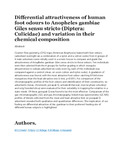Differential attractiveness of human foot odours to Anopheles gambiae Giles sensu stricto (Diptera: Culicidae) and variation in their chemical composition
Date
2013-10-01Author
Omolo, M. O.
Njiru, B
Ndiege, I O
Musau, R M
Hassanali, A.
Metadata
Show full item recordAbstract
Counter flow geometry (CFG) traps (American Biophysics) baited with foot odours (adsorbed overnight on a combination of a nylon and a cotton socks) from 4 groups of 4 male volunteers were initially used in a screen-house to compare and grade the attractiveness of Anopheles gambiae Giles sensu stricto to these odours. Ten individuals were then selected from the 4 groups for further grading in which mosquito attractiveness to odours adsorbed on socks worn by each of the individuals was compared against a control (clean, un-worn cotton and nylon socks). A gradation of attractiveness was found, with the most attractive foot odour catching 8-fold more mosquitoes than the least attractive one (t-test, p=0.001). For comparison of the chromatographic profiles of the foot odours and identification of their constituents, six adsorbents (tenax, chromsorb, porapak Q, activated charcoal, reverse phase octadecyl and octyl bonded silica) were evaluated for their suitability in trapping the volatiles in a static mode. Of these, porapak Q was found to be the most effective. Comparison of the gas-chromatographic (GC) and gas chromatography-linked mass spectrometry (GC-MS) profiles of blends collected from the most and least attractive feet on porapak Q adsorbent revealed both qualitative and quantitative differences. The implication of our finding on differential attraction of An. gambiae to their preferred feeding site of different human subjects is highlighted.
URI
https://doi.org/10.1016/j.actatropica.2013.07.012https://www.sciencedirect.com/science/article/abs/pii/S0001706X13001927?via%3Dihub
http://r-library.mmust.ac.ke/123456789/1776
Collections
- Gold Collection [1008]

